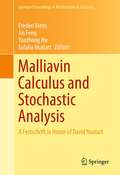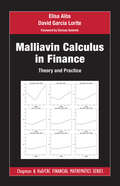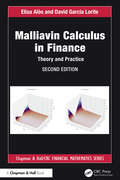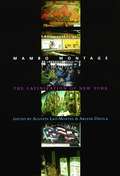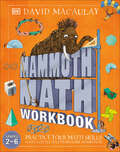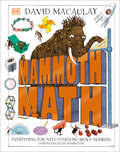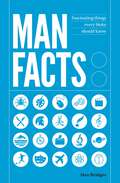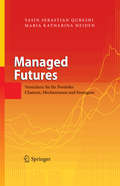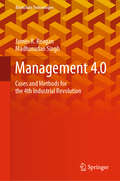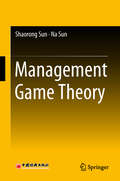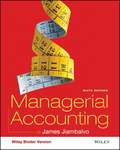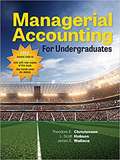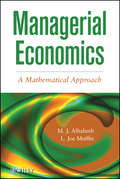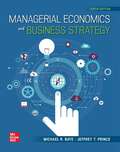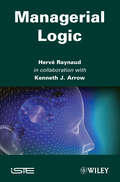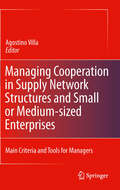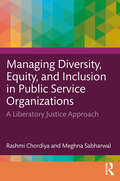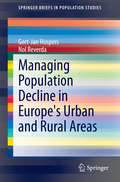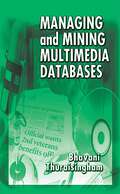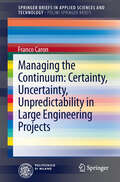- Table View
- List View
Malliavin Calculus and Stochastic Analysis
by Jin Feng Eulalia Nualart Frederi Viens Yaozhong HuThe stochastic calculus of variations of Paul Malliavin (1925 - 2010), known today as the Malliavin Calculus, has found many applications, within and beyond the core mathematical discipline. Stochastic analysis provides a fruitful interpretation of this calculus, particularly as described by David Nualart and the scores of mathematicians he influences and with whom he collaborates. Many of these, including leading stochastic analysts and junior researchers, presented their cutting-edge research at an international conference in honor of David Nualart's career, on March 19-21, 2011, at the University of Kansas, USA. These scholars and other top-level mathematicians have kindly contributed research articles for this refereed volume.
Malliavin Calculus in Finance: Theory and Practice (Chapman and Hall/CRC Financial Mathematics Series)
by Elisa Alos David Garcia LoriteMalliavin Calculus in Finance: Theory and Practice aims to introduce the study of stochastic volatility (SV) models via Malliavin Calculus. Malliavin calculus has had a profound impact on stochastic analysis. Originally motivated by the study of the existence of smooth densities of certain random variables, it has proved to be a useful tool in many other problems. In particular, it has found applications in quantitative finance, as in the computation of hedging strategies or the efficient estimation of the Greeks. The objective of this book is to offer a bridge between theory and practice. It shows that Malliavin calculus is an easy-to-apply tool that allows us to recover, unify, and generalize several previous results in the literature on stochastic volatility modeling related to the vanilla, the forward, and the VIX implied volatility surfaces. It can be applied to local, stochastic, and also to rough volatilities (driven by a fractional Brownian motion) leading to simple and explicit results. Features Intermediate-advanced level text on quantitative finance, oriented to practitioners with a basic background in stochastic analysis, which could also be useful for researchers and students in quantitative finance Includes examples on concrete models such as the Heston, the SABR and rough volatilities, as well as several numerical experiments and the corresponding Python scripts Covers applications on vanillas, forward start options, and options on the VIX. The book also has a Github repository with the Python library corresponding to the numerical examples in the text. The library has been implemented so that the users can re-use the numerical code for building their examples. The repository can be accessed here: https://bit.ly/2KNex2Y.
Malliavin Calculus in Finance: Theory and Practice (Chapman and Hall/CRC Financial Mathematics Series)
by Elisa Alos David Garcia LoriteMalliavin Calculus in Finance: Theory and Practice, Second Edition introduces the study of stochastic volatility (SV) models via Malliavin Calculus. Originally motivated by the study of the existence of smooth densities of certain random variables, Malliavin calculus has had a profound impact on stochastic analysis. In particular, it has been found to be an effective tool in quantitative finance, as in the computation of hedging strategies or the efficient estimation of the Greeks.This book aims to bridge the gap between theory and practice and demonstrate the practical value of Malliavin calculus. It offers readers the chance to discover an easy-to-apply tool that allows us to recover, unify, and generalize several previous results in the literature on stochastic volatility modeling related to the vanilla, the forward, and the VIX implied volatility surfaces. It can be applied to local, stochastic, and also to rough volatilities (driven by a fractional Brownian motion) leading to simple and explicit results.Features Intermediate-advanced level text on quantitative finance, oriented to practitioners with a basic background in stochastic analysis, which could also be useful for researchers and students in quantitative finance Includes examples on concrete models such as the Heston, the SABR and rough volatilities, as well as several numerical experiments and the corresponding Python scripts Covers applications on vanillas, forward start options, and options on the VIX. The book also has a Github repository with the Python library corresponding to the numerical examples in the text. The library has been implemented so that the users can re-use the numerical code for building their examples. The repository can be accessed here: https://bit.ly/2KNex2Y. New to the Second Edition Includes a new chapter to study implied volatility within the Bachelier framework. Chapters 7 and 8 have been thoroughly updated to introduce a more detailed discussion on the relationship between implied and local volatilities, according to the new results in the literature.
Malware Detection on Smart Wearables Using Machine Learning Algorithms (Studies in Systems, Decision and Control #549)
by Alvaro Rocha Fadele Ayotunde AlabaThis book digs into the important confluence of cybersecurity and big data, providing insights into the ever-changing environment of cyber threats and solutions to protect these enormous databases. In the modern digital era, large amounts of data have evolved into the vital organs of businesses, providing the impetus for decision-making, creativity, and a competitive edge. Cyberattacks pose a persistent danger to this important resource since they can result in data breaches, financial losses, and harm to an organization's brand.
Mambo Montage: The Latinization of New York City
by Arlene Dávila Agustín Laó-MontesNew York is the capital of mambo and a global factory of latinidad. This book covers the topic in all its multifaceted aspects, from Jim Crow baseball in the first half of the twentieth century to hip hop and ethno-racial politics, from Latinas and labor unions to advertising and Latino culture, from Cuban cuisine to the language of signs in New York City.Together the articles map out the main conceptions of Latino identity as well as the historical process of Latinization of New York. Mambo Montage is both a way of imagining latinidad and an angle of vision on the city.
Mammoth Math Workbook: Practice Your MathsSkills with a Little Help from Some Mammoths
by DKDavid Macaulay's troupe of ever-inquisitive mammoths help you develop core number skills and much more in this highly original maths workbook.Do you struggle to engage with maths? Would you like to build your confidence in maths both at home and in the classroom? Or are you a maths whizz who wants to learn more? With the encouragement of Macaulay's endearing mammoths and elephant shrews, this Mammoth Maths Workbook will help you master the basics of numbers, counting, calculating, measuring, shapes, data, puzzles, codes, and more.Throughout the workbook, the mammoths act as your guide as they first explain a maths concept and then reinforce it with practice questions and fun activities. And there are answers at the back to check that you're on the right path. Developed in conjunction with a maths teacher, the Mammoth Maths Workbook covers all the key areas of the curriculum for children aged 7-11, including fractions, decimal numbers, percentages, multiplication and division, measurement, geometry, patterns and sequences, ratio, and probability, and cement your learning with easy-to-follow instructions and clear examples.Ideal for budding mathematicians and reluctant learners alike, the Mammoth Maths Workbook offers a fun and light-hearted approach to improving your maths skills.
Mammoth Math: Everything You Need to Know About Numbers (DK David Macaulay How Things Work)
by David MacaulayIntroducing an off-beat guide to math from award-winning author and illustrator David Macaulay.Math is all around you…if you look closely enough! From computer games to bridges, shopping malls to game shows, mathematics truly is everywhere. David Macauley&’s terrific troupe of curious mammoths will lead you through the basics of math, including numbers, calculation, geometry, measurement and so much more in this highly original guide to math for kids aged 8+. In Mammoth Math, not only will you learn the essential principles of math, you&’ll enjoy learning about them too! From start to finish, the mammoths are your guide as they seek to understand the math! These intrepid demonstrators will go to incredible lengths to educate and entertain, as they wrestle with adding or subtracting numbers, measuring angles, creating a pie chart, solving equations, and much more.Observing and recording the mammoths&’ behavior is best-selling illustrator David Macaulay. Renowned for his ability to explain complex ideas with simple genius, Macaulay captures the oddball humor of his subject matter, making Mammoth Math the perfect introduction to math for young learners to love. Discover math as you&’ve never known it before, with: - Fun-filled illustrations show Macaulay&’s mammoths exploring mathematical ideas demonstrating key mathematical principles in unusual and amusing ways.- An action-packed alternative to dry, unappealing math textbooks.- Supporting panels contain diagrams and extra information to aid understanding.- The book is divided into chapters, each focusing on a different branch of mathThe ideal math book for all children aged 8+ as well as for reluctant math learners who don&’t think math is for them, Mammoth Math includes a highly original and unique approach to the subject, with over 60 topics covered in total, including numbers geometry, measurement and operations. Encompassing all-new illustrations featuring Macaulay&’s trademark mammoths, familiar to readers of The Way Things Work - a best-selling book of David Macaulay&’s, which has sold over 3 million copies worldwide!Join the math journey today! Solving the problem is only one mammoth ride away!
Man Facts: Fascinating Things Every Bloke Should Know
by Dan BridgesIt’s time to celebrate your inner geek with this treasure trove of lists and prime cuts of knowledge. Ranging across history, science and the natural world, taking in sport, film, food and much more, Man Facts gives you a wealth of up-to-date stats and eye-opening trivia that will make you a general-knowledge genius. Dig in.
Man Facts: Fascinating Things Every Bloke Should Know
by Dan BridgesIt’s time to celebrate your inner geek with this treasure trove of lists and prime cuts of knowledge. Ranging across history, science and the natural world, taking in sport, film, food and much more, Man Facts gives you a wealth of up-to-date stats and eye-opening trivia that will make you a general-knowledge genius. Dig in.
Managed Futures
by Yasin Sebastian Qureshi Maria Katharina HeidenDie Anlageklasse der Managed Futures ist trotz ihrer fast 50-jährigen Geschichte bei Deutschlands Anlegern nahezu unbekannt. Dabei bieten sie attraktive Renditen bei akzeptablen Risiken. Das Buch bietet interessierten Anlegern alle wichtigen Hintergrundinformationen, um eine qualifizierte Entscheidung über Investitionen in Managed Futures treffen zu können. Die Autoren stellen dar, wie Renditen erwirtschaftet werden, welche Kosten entstehen, welche Risiken bestehen und wie sich Managed Futures im Vergleich zu anderen Investitionen entwickelt haben.
Management 4.0: Cases and Methods for the 4th Industrial Revolution (Blockchain Technologies)
by Madhusudan Singh James R. ReaganThis book provides a comprehensive review of industry 4.0 and its applications, discussing the history of industry evaluation, including industry 1.0, 2.0, 3.0 and 4.0, and the future structure of industry evaluation. It also examines the effects and impact of various technologies in industry and presents new interdisciplinary business models based on advanced technologies with the help of use cases. Lastly, it highlights the benefits of technological implementation in industry using examples of real-world applications, providing a robust and reliable technological conceptual framework and roadmap for decision-makers in all areas of industry involved transformation.
Management Game Theory
by Shaorong Sun Na SunThis book primarily addresses various game theory phenomena in the context of management practice. As such, it helps readers identify the profound game theory principles behind these phenomena. At the same time, the game theory principles in the book can also provide a degree of guidance for solving practical problems.As one of the main areas in management research, there is already an extensive body of literature on game theory. However, it remains mainly theoretical, focusing on abstract arguments and purely numerical examples purely. This book addresses that gap, helping readers apply game theory in their actual management or research work.
Management and Intelligent Decision-Making in Complex Systems: An Optimization-Driven Approach
by Shuai Li Ameer Hamza Khan Xinwei CaoIn this book, the authors focus on three aspects related to the development of articulated agents: presenting an overview of high-level control algorithms for intelligent decision-making of articulated agents, experimental study of the properties of soft agents as the end-effector of articulated agents, and accurate management of low-level torque-control loop to accurately control the articulated agents. This book summarizes recent advances related to articulated agents. The motive behind the book is to trigger theoretical and practical research studies related to articulated agents.
Managerial Accounting
by James JiambalvoThis book is intended to drive home the fundamental ideas of managerial accounting and motivate students to actually want to study the subject and focuses on the fundamental topics of managerial accounting. It helps student make direction connections between techniques in the business world, and readers' future careers using real cases and real managers' comments on real company issues. The book also helps students develop decision making through incremental analysis and stresses the fact that you Get What You Measure throughout the program. It is designed for a one semester managerial accounting course at both the undergraduate and MBA level.
Managerial Accounting for Undergraduates
by James Wallace Theodore Christensen Scott HobsonMany undergraduate managerial accounting textbooks focus primarily on calculations and formulas and how to apply these accounting skills in a manufacturing environment. However, business professionals must be able to apply their technical accounting knowledge and expertise in a broader context in making good business decisions. Moreover, because the U.S. market is increasingly service oriented, professionals must develop experience in applying these skills to decision making in a service environment. Having spent several years supplementing existing textbook problems with more real-world and service industry examples, we saw a need for a new approach. Hence, we focus on helping students to (1) develop strong analytical skills and (2) apply them in realistic decision-making contexts. Finally, we have written the book with a heavy emphasis on managerial decisions in service and merchandising enterprises. Managerial Accounting for Undergraduates is intended for use in the first managerial accounting course at the undergraduate level-one that balances the development of management accounting tools with their implementation in decision making. This book teaches future business professionals how to read, analyze, and interpret accounting and other company, industry, and economic data to make informed business decisions.
Managerial Accounting, Seventh Edition
by Al L. Hartgraves Wayne J. MorseThe seventh edition presents managerial accounting in the context of a big-picture, decision oriented, business setting. It integrates traditional coverage with contemporary topics to engage students to read further and understand the materials presented. The book provides a framework for identifying and analyzing decision alternatives and for evaluating success or failure in accomplishing such organizational goals.
Managerial Economics
by M. J. Alhabeeb L. J. MoffittUncertainty is present in every managerial decision, and Managerial Economics: A Mathematical Approach effectively demonstrates the application of higher-level statistical tools to inform and clarify the logic of problem solving in a managerial environment.While illuminating managerial decision-making from all possible angles, this book equips readers with the tools and skills needed to recognize and address uncertainty. The book also explores individual, firm, and market-level decisions; discusses all possible risks and uncertainties encountered in the decision-making process; and prepares readers to deal with both epistemic and aleatory uncertainty in managerial decisions. Managerial Economics features:* An emphasis on practical application through real-life examples and problems* An accessible writing style that presents technical theories in a user-friendly way* A mathematical and statistical point of view that reveals the presence of uncertainty inherent in managerial decisions* Thoroughly class-tested material including problems at the end of each chapter, case study questions, review exercises, and objectives that summarize the main discussionsManagerial Economics is an excellent book for upper-undergraduate and graduate-level courses in business and economics departments. The book is also an ideal reference and resource for managers, decision makers, market analysts, and researchers who require information about the theoretical and quantitative aspects of the topic.
Managerial Economics and Business Strategy
by Jeff Prince Michael R. BayeManagerial Economics and Business Strategy has been revised to include updated examples and problems, but it retains all of the basic content that made previous editions a success. By teaching managers the practical utility of basic economic tools such as present value analysis, supply and demand, regression, indifference curves, isoquants, production, costs, and the basic models of perfect competition, monopoly, and monopolistic competition. <p><P> This 10th edition retails the emphasis on real-world examples and modern topics along with unique coverage found nowhere else: oligopoly, penetration pricing, multistage and repeated games, foreclosure, contracting, vertical and horizontal integration, networks, bargaining, predatory pricing, principal agent problems, raising rival’s costs, adverse selection, auctions, screening and signaling, search, limit pricing, and a host of other pricing strategies for firms enjoying market power. This balanced coverage of traditional and modern microeconomic tools makes it appropriate for a wide variety of managerial economics classrooms.
Managerial Logic
by Harvé RaynaudThe publication of the first book by Kenneth Arrow and Hervé Raynaud, in 1986, led to an important wave of research in the field of axiomatic approach applied to managerial logic. Managerial Logic summarizes the prospective results of this research and offers consultants, researchers, and decision makers a unified framework for handling the difficult decisions they face. Based on confirmed results of experimental psychology, this book places the problem in a phenomenological framework and shows how the influence of traditional methods has slowed the effective resolution of these problems. It provides a panorama of principal concepts and theorems demonstrated on axiomatized methods to guide readers in choosing the best alternatives and rejecting the worst ones. Finally, it describes the obtained extensions, often paradoxical, reached when these results are extended to classification problems. The objective of this book is also to allow the decision maker to find his way through the plethora of “multicriterion methods” promoted by council organizations. The meta-method it proposes will allow him to distinguish the wheat from the chaff. The collaboration with Kenneth Arrow comes essentially from the fact that his work influenced all subsequent works quoted in this book. His famous impossibility theorem, his gem of a PhD thesis, and his various other works resulted in him receiving the Nobel Prize for economy just before meeting Hervé Raynaud who was at that time a visiting professor at Berkeley University in California. Their mutual publications serve as the basis for the axiomatic approach in multicriterion decision-making.
Managing Cooperation in Supply Network Structures and Small or Medium-sized Enterprises
by Agostino VillaManaging Cooperation in Supply Network Structures and Small- or Medium-sized Enterprises outlines different approaches to the analysis of the organisation of small- or medium-sized enterprises (SMEs). Owing to the increased competition in the worldwide market, several SMEs operating in the same industrial sectors have agreed collaborative market strategies, both for raw material procurement and for final product delivery. The resulting networks, however, have a tendency to suffer from a lack of organization, which minimizes their impact on the product and labour markets, and causes a weak negotiation capacity within their supply chain. Managing Cooperation in Supply Network Structures and Small- or Medium-sized Enterprises aims to give managers of SMEs a simple methodology that helps them to understand when and why becoming a partner in an SME network can be profitable for their enterprise. It discusses the most critical organizational problems and identifies which procedures must be known to become a collaborative member of the network. Policy-makers, as well as managers and executives, will be able to appreciate the key issues in creating and managing healthy networks that serve global market requirements in the major industrial sectors. Managing Cooperation in Supply Network Structures and Small- or Medium-sized Enterprises enables them to evaluate the efficiency of their organization, and to estimate both the network performance and the opportunity for further development.
Managing Diversity, Equity, and Inclusion in Public Service Organizations: A Liberatory Justice Approach
by Meghna Sabharwal Rashmi ChordiyaManaging Diversity, Equity, and Inclusion in Public Service Organizations: A Liberatory Justice Approach is a textbook designed to facilitate critical and courageous conversations that recognize our differences, including our privileged and marginalized social identities, and engage readers in the principles and practice of solidarity to transform systems of oppression. Examining dimensions of race, gender, sexual orientation, disabilities, and their intersectionality in the context of diverse, multigenerational organizations, this leading-edge new textbook redefines and reimagines the role of public service in fostering meaningful, authentic, sustainable, and transformative change.While diversity is now a standard topic in books on public personnel and human resource management, authors Rashmi Chordiya and Meghna Sabharwal offer a deeper, nuanced, and reflective understanding of many of the systematic and often covert ways in which marginalized and minoritized groups can face barriers to full and equal participation in decision-making, access to resources, and opportunities for advancement and growth. Taking a holistic, liberatory public service approach, the book explores what it would mean if public service systems were reimagined, and goals aligned and transformed, to serve an “all means all” public.Other unique features of this book include developing a nuanced understanding of trauma of oppression from neurobiological, sociological, and historical perspectives. This book supports the reader in exploring ways of cultivating individual and organizational competencies and capacities for envisioning and implementing trauma-informed, repair and healing-centered approaches to public service that compassionately center the margins. To encourage learner engagement and to connect theory to practice, this book offers several case studies. Each chapter contains a description of big ideas, big questions, and key concepts and teachings offered in that chapter, as well as chapter summaries and deep dive resources. Throughout the book, the authors offer boxed invitations to pause and use reflective prompts to engage readers with the core concepts and key teachings of the book. Managing Diversity, Equity, and Inclusion in Public Service Organizations is required reading for all current and future public administrators and nonprofit leaders.
Managing Engineered Assets: Principles and Practical Concepts
by Joe E. Amadi-EchenduThis textbook deals with engineering, science, technical, legal, financial, ICT, logistics and people management topics necessary for managing engineered assets such as all man-made tools, gadgets, buildings, equipment, machines, infrastructure, large-scale physical and industrial facilities and systems which pervade all sectors of industry. By coalescing concepts, principles, practices, and practical issues from the relevant multi-disciplines, the book addresses the body of knowledge required for managing engineered assets in the 4IR and Society 5.0 era and beyond.The book is written for:Scholars and students who intend to strengthen or acquire knowledge about the concepts, principles, and practice of managing engineered assets;Managers of engineered assets in both the public and private sectors who aim to improve asset management practice for their organisational purposes and missions;Policymakers and regulators in order to improve policymaking, governance, assessment and evaluation frameworks on the management of engineered assets;The broader audience concerned about the sustainable management of engineered assets that constitute our built environment and provide the means for industry and livelihood.
Managing Population Decline in Europe's Urban and Rural Areas
by Gert-Jan Hospers Nol ReverdaThis book explores the challenges population decline presents for Europe's urban and rural areas. It features recent demographic data and trends not only for Europe as a whole, but also for selected countries, and compares growth and shrinkage from a historical as well as a theoretical perspective. In addition, the book critically reviews relevant notions from geography, sociology, and public administration. It also identifies good practices across Europe. Throughout, theories are complemented with concrete examples and proposals are made on how to tackle demographic shrinkage in European cities and villages, from attempts to attract new residents to the countryside to innovative ways to guarantee public services. In the end, the authors conclude that solving the challenges caused by population decline require novel ways of thinking and provide answers to such future-oriented questions as: how to ensure the quality of life in an environment that is inhabited by fewer and older people, what investments are needed, and which actors should be involved. Managing Population Decline in Europe's Urban and Rural Areas offers detailed coverage of an underestimated and complex governance issue that asks for solutions in which citizens have to play an important role. It concludes that shrinkage requires a rethink of the specific tasks and roles of government and presents a way forward based on initiatives currently underway throughout Europe. The book will be a valuable resource for population policy makers as well as students and researchers interested in human geography, urban planning, rural development, European studies, public administration, and other social sciences.
Managing and Mining Multimedia Databases
by Bhavani ThuraisinghamThere is now so much data on the Web that managing it with conventional tools is becoming almost impossible. To manage this data, provide interoperability and warehousing between multiple data sources and systems, and extract information from the databases and warehouses, various tools are being developed. In fact, developments in multimedia databa
Managing the Continuum: Certainty, Uncertainty, Unpredictability in Large Engineering Projects
by Franco CaronThe brief will describe how to develop a risk analysis applied to a project , through a sequence of steps: risk management planning, risk identification, risk classification, risk assessment, risk quantification, risk response planning, risk monitoring and control, process close out and lessons learning. The project risk analysis and management process will be applied to large engineering projects, in particular related to the oil and gas industry. The brief will address the overall range of possible events affecting the project moving from certainty (project issues) through uncertainty (project risks) to unpredictability (unforeseeable events), considering both negative and positive events. Some quantitative techniques (simulation, event tree, Bayesian inference, etc.) will be used to develop risk quantification. The brief addresses a typical subject in the area of project management, with reference to large engineering projects concerning the realization of large plants and infrastructures. These projects are characterized by a high level of change, uncertainty, complexity and ambiguity. The brief represents an extension of the material developed for the course Project Risk Analysis and Management of the Master in Strategic Project Management (Erasmus Mundus) developed jointly by Politecnico di Milano, Heriot Watt University (Edimburgh) and Umea (Sweden). The brief may be used both in courses addressing project management subjects and by practitioners as a guide for developing an effective project risk management plan.
